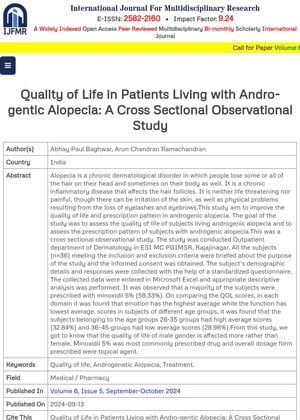Quality of Life in Patients Living with Androgenetic Alopecia: A Cross-Sectional Observational Study
September 2024
in “
International Journal For Multidisciplinary Research
”

TLDR Androgenic alopecia affects men's quality of life more than women's.
The study assessed the quality of life (QOL) and prescription patterns in 36 patients with androgenic alopecia at a dermatology outpatient department in India. Using a standardized questionnaire, it was found that minoxidil 5% was the most commonly prescribed treatment (58.33%). Emotional well-being had the highest average QOL score, while functional well-being had the lowest. Patients aged 26-35 had higher average QOL scores (32.84%) compared to those aged 36-45 (28.96%). The study concluded that androgenic alopecia affects the quality of life more significantly in males than females, with topical agents being the predominant form of treatment.





